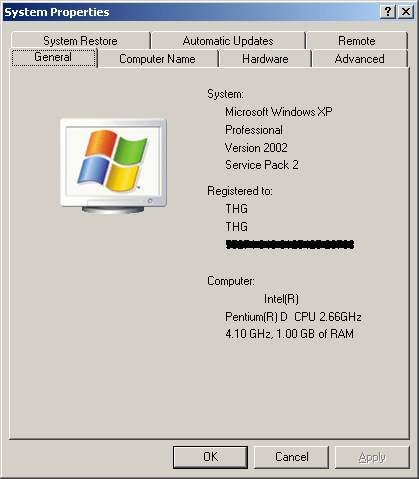A 4.1 GHz Dual Core at $130 - Can it be True?
Conclusion, Continued
Our comprehensive benchmarks show that an extremely overclocked Pentium D attains the best performance numbers for nearly every area of activity, including video editing and decoding, audio encoding, office applications, photo retouching and various 3D games. The Pentium D 805 also leads in the multi-tasking arena, where multiple applications execute in parallel. Those who work with complex filters and effects in Adobe PhotoShop CS2 or who use Pinnacle Studio Plus 10 for HD video editing and related rendering and encoding work will also find that this budget $130 CPU is best for their needs. Even gamers can unpack this secret weapon at their next LAN party, without others recognizing that they've got a monster inside their PC case. In any event, the results of doubling the CPU clock rate should earn them some respect!
What a view! Windows shows a CPU clock rate of 4.1 GHz. Marks of respect at LAN parties and in your circle of friend should soon follow the acquisition of one of these babies. Right now, nobody offers more capability, either!
In conclusion, we want to say that it's probably wise to also consider the risks with regard to this project. First and foremost, power consumption increases in direct proportion to clock rate: at 4.1 GHz, a fully-loaded system measures out at 210 W, more than twice the nominal specification for this CPU, which Intel pegs at 95 W. High current consumption of 125 A (!) also commands respect, and contributes to high heat output from the switching regulator. That's why we strongly recommend purchase of a high-end CPU cooler and a supplementary fan. Nevertheless, the CPU isn't subject to damage from overheating, thanks to "Thermal Monitor 2", which means overheating leads to clock rate throttling rather than device failure. That's also why the CPU core voltage should be raised only within limits, and more than 1.7 V is decidedly unwise.
Those who find themselves thinking of a new system project as a result of this story should probably get going quickly. The $130 or so a Pentium D 805 will cost you is money well spent in any case. Those who switch away from AMD will also have to spring for a new motherboard (at least $130 for a suitably equipped model) along with 1 GB of quality DDR2 RAM (at least $100). The joy of (re)building such a system adds nothing to the cost, however. For die-hard AMD fans this will mean a change of sides, and possibly politics. But hey, why not, if the results are worthwhile?
Join our discussion on this topic
Get Tom's Hardware's best news and in-depth reviews, straight to your inbox.
Current page: Conclusion, Continued
Prev Page Conclusion: The 4.1 GHz Dual Core Delivers Peak Performance For Pocket ChangeTom's Hardware is the leading destination for hardcore computer enthusiasts. We cover everything from processors to 3D printers, single-board computers, SSDs and high-end gaming rigs, empowering readers to make the most of the tech they love, keep up on the latest developments and buy the right gear. Our staff has more than 100 years of combined experience covering news, solving tech problems and reviewing components and systems.

